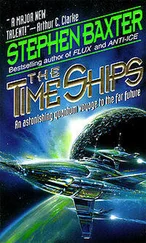The fastest air-breathing aircraft to date is NASA’s X-43A which has reached Mach 9.8 (that is, 9.8 times the speed of sound) using scramjet technology. In theory it is believed that scramjets could reach almost orbital velocity (which is Mach 25). The great advantage is in weight savings; unlike a rocket such as the space shuttle, a scramjet would need to carry virtually no oxidiser to burn its fuel, extracting it all from the air.
This is how the Valkyrie flies. Four times the size of the space shuttle, with its black heat-resistant tiles and white insulation reminiscent of the shuttle’s bodywork, the Valkyrie returns from orbit using friction with the atmosphere to brake, like the shuttle, and glides most of the way home. But to return to orbit it uses air-breathing turbojet engines to get off the ground, and switches to a scramjet mode at three times the speed of sound. It has rocket engines for the final burn to orbit. All this is powered by a fusion engine.
A compromise design with some potential is Skylon, being developed by a company called Reaction Engines Ltd based in Bristol, UK. Skylon’s engine works like a conventional jet up to five times the speed of sound at twenty-six kilometres altitude, at which point the air inlets close and the engine switches to an internal liquid oxygen supply, working as a rocket to complete the climb to orbit. As of February 2009, ESA, the European Space Agency, announced that it was funding a million-euro development of the engines.
Perhaps when the new private spacecraft start flying we will find ourselves on the verge of a new transport boom, like the spread of the railways in the nineteenth century. Aside from access to orbit, spaceplanes could be used for suborbital hops, such as a two-hour flight from New York to Sydney.
And, I suppose, other applications could be military, as we see in Avatar . Valkyrie-class vehicles acting like sub-orbital C-130s could deliver troops and materiel to combat zones anywhere in the world within hours.
But even if we do start getting into space at some reasonable price—so what? If you’re a budding space prospector, a proto-RDA, what are you supposed to be mining, the vacuum? As we’ve seen, in the wake of the Apollo missions scientists believed that even the closest destination, the moon, entirely lacked the most basic resource, water.
It turns out, though, that they might have been too hasty. And beyond the moon, the sky seems to be full of riches.
After Apollo, the space scientists examining the returned moon rocks thought that they contained no trace of water. They concluded that the moon must be dryer than old bones (literally).
But this conclusion has long been questioned. It could be that any evidence of water those early researchers did see was dismissed because of fears of contamination from Earth’s atmosphere; none of the boxes in which the lunar samples were returned kept their vacuum.
The picture began to change significantly in 1994 when a joint NASA–military satellite called Clementine was thought to have detected traces of water frozen in the shadows of a lunar polar crater. This raised great hopes, though doubt was cast on the result later. In 1999 another NASA probe called Lunar Prospector was deliberately crashed into a south pole crater, in the hope of raising a plume of dust laced with sparkling water—but again the results were inconclusive.
Today, however, thanks to discoveries in 2009 from India’s Chandrayaan-1 spacecraft, and NASA’s Lunar Reconnaissance Orbiter and Lunar Crater Observation and Sensing Satellite, we believe there might be three sources of water on the moon. The shadows of polar craters, forever dark, could act as cold traps. There could be trace amounts of water in volcanic glasses. And finally there might be water scattered over the moon’s surface—just traces, the slightest dew in the regolith (the lunar soil), delivered by comet impacts after the moon’s formation.
Water in space would be hugely valuable, far more so than gold, given the cost of hauling water up from Earth. On the moon, water would support life, and using electrolysis (passing an electric current through it) water can be broken down into hydrogen and oxygen to make rocket fuel. The moon could become a filling station outside Earth’s deep gravity field that could be used to support a general expansion into the solar system, just as was dreamed of before Apollo.
Another key resource to be found on the moon is helium-3, the isotope of this light element that is most useful in fusion reactors. Unfortunately, like the water, the helium-3 is implanted thinly in the regolith, having been deposited there by the solar wind over aeons. (In the Avatar universe RDA does in fact maintain a lunar helium extraction facility.)
The moon, however, is only the beginning of our search for water and other resources beyond the Earth. And it may not even be the first place we’ll look. In April 2010 the Obama administration set out a startling and terrifically exciting new vision for the future of American manned spaceflight. The next small step an American astronaut makes on another world might not be the moon, or even Mars, that traditional destination, but an asteroid.
On the very first day of the nineteenth century, a new world was discovered. Smaller than any planet, it was an asteroid, now called Ceres, the first discovered, and the largest of them all, as it turned out, circling in the great waste between Mars and Jupiter. Other asteroids soon followed: more than four hundred lumps of rock and ice were discovered by the end of the nineteenth century. The asteroids are thought to be relics of the solar system’s formation, fossil remnants never gathered up into planets.
Then in 1898 a new type of asteroid was discovered. Christened Eros, this flying mountain can wander within the orbit of Mars, and even comes distressingly close to Earth. Today we know of many asteroids whose paths take them near our planet. Known as near-Earth objects (NEOs), most of them are only a few kilometres across or less. There may be as many as two thousand NEOs more than a kilometre across, and maybe two hundred thousand more than a hundred metres across. About a fifth of them will eventually hit Earth—“eventually,” in this context, meaning over billions of years. The famous impact sixty-five million years ago which appears to have caused the extinction of the dinosaurs was in fact caused by a NEO. Today we are tracking NEOs with programmes run by NASA and other agencies; one day we may be able to push away any threats.
However it is not the threat of the NEOs that interests us here, but their promise.
Obama’s new vision would send astronauts to a NEO. We know we can reach them; already asteroid Eros has been orbited by an unmanned spacecraft. And surprisingly, perhaps, some of the NEOs come so close to Earth that it would take less fuel to reach a NEO and return than it takes to get to the surface of the moon and back. The catch is that it takes much longer to get to a NEO than the moon. In a way that’s a benefit; an asteroid mission could be a rehearsal for the even longer missions to Mars to come. The operation would be tricky; an asteroid’s gravity is so low that “landing” would be more like docking with an immense natural space station. Once there the astronauts could trial technologies for pushing rogue NEOs away from an Earth impact.
And NEOs themselves could prove to be very valuable prizes indeed.
Some NEOs are flying mountains of natural steel and precious metals, such as gold and platinum. The prospect of reaching what is known as a C-type asteroid, full of organic compounds, is even more exciting, because the C-types contain water. Not only that, with suitable engineering, you can also extract from the asteroid dirt carbon dioxide, nitrogen, sulphur, ammonia, phosphates—all the requirements of a life-support system, or a rocket fuel factory. You can also use the asteroid dirt to make glass, fibreglass, ceramics, concrete.
Читать дальше










